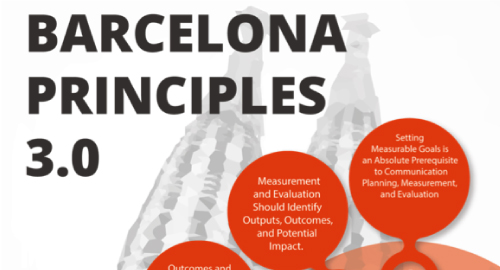Many organizations are now trying to get used with the new restrictions imposed by COVID-19 or even try to transform themselves for the new normal. As part of the transformation process, the measurement matrix becomes one of the most important elements that also needs to be transformed. Read more about the transformation here.
To start preparing your organization for the integrated measurement matric, there are a few elements that need to be prepared. AMEC, through its recent AMEC Global Summit 2020, introduced Barcelona Principles 3.0, a set of seven voluntary guidelines to measure the efficiency of Communications campaign, with key highlights as follows:

The above principles are basically our foundation in conducting integrated measurement properly. From an organization’s point of view, however, there are only four steps that you actually need to complete to start this transformation:
- Set a SMART Organizational Goal
Yes, a goal needs to be SMART: Specific, Measurable, Achievable, Realistic, Timely. Otherwise, it will only result in communications activities being all over the place. In addition, it’s also important to differentiate business goals with communications goals. Here’s an example:
| Business Goal | SMART Communications Goal |
| Become top of mind in the respective industry | Increase brand awareness among millennials and Gen Z in Java by 70% within a year |
To set a SMART goal, simply start by answering these questions:
- What exactly does your organization want to achieve? What’s the difference between that goal and your current situation?
- How will you know when you have reached it?
- When do you want to reach it?
- Break down the Organizational SMART Goal into Divisional SMART Goals
Once the organizational SMART goal is finalized, get each division to define their respective SMART goals and outcomes consistently across channels (paid, earned, shared, owned – PESO). This is important because all divisions need to contribute to the same organizational goal and have their own measurement components.
- Agree on the measurement plan
Many times, the measurement plan is not decided prior to the activities. What is agreed is just the communications activities. Only when the activities are rolled out, we are discussing how we can measure the success. As a result, we hardly know the baseline (situation prior to the activities) or miss some components of the measurement.
It is therefore necessary to make measurement planning and get all relevant parties to agree on it prior to the implementation of any communications activities. Some measurement components that need to be agreed on:
- the KPIs
- tools and tracking methods
- benchmark
- Have a specific team that focuses in measurement
We understand how complex an organizational structure could be. There are people and divisions in charge of and specialize in different things. They also have different KPIs. To measure effectively, however, an integrated measurement system is needed. This is because a proper measurement needs to collect data and analyze performance consistently across all applicable communication channels from all divisions, including but not limited to:
- Online and Offline Earned Media Content
- Owned Social Channels (Twitter, Facebook, Instagram, YouTube, etc.)
- Owned Websites and Microsites
- Organic and Paid Search
- Paid Advertising (Programmatic, Display, etc.)
- Surveys, Interviews, etc.
- Events
- Influencers (Paid and Earned)
A team, which can lead the measurement from each division and integrate it into one matrix is therefore highly needed.
Once you are completing the above four guidelines, you are already on the right track to do your integrated measurement. Reach out to us at maverick@maverick.co.id should you need a discussion partner.
Do also fill in a questionnaire that can map out your measurement maturity through this link. This is a survey-based diagnostic tool by AMEC, designed to help professionals at any level of sophistication, and from any type of organization, to better plan their measurement and evaluation journey by clearly benchmarking where they are starting from in the process.
Good luck in your journey into measurement. What can be measured can be managed. What does not get measured often dissipates into a flurry of activities signifying nothing.
Written by Karen Kusnadi, Manager.
